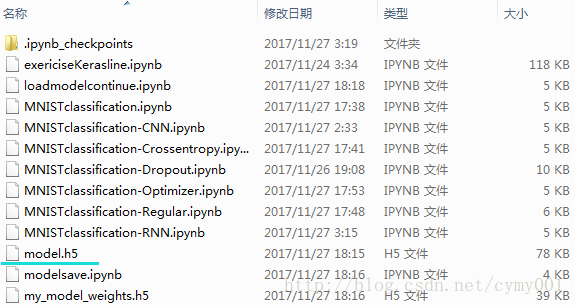我们以MNIST手写数字识别为例
import numpy as np
from keras.datasets import mnist
from keras.utils import np_utils
from keras.models import Sequential
from keras.layers import Dense
from keras.optimizers import SGD
# 载入数据
(x_train,y_train),(x_test,y_test) = mnist.load_data()
# (60000,28,28)
print('x_shape:',x_train.shape)
# (60000)
print('y_shape:',y_train.shape)
# (60000,28,28)->(60000,784)
x_train = x_train.reshape(x_train.shape[0],-1)/255.0
x_test = x_test.reshape(x_test.shape[0],-1)/255.0
# 换one hot格式
y_train = np_utils.to_categorical(y_train,num_classes=10)
y_test = np_utils.to_categorical(y_test,num_classes=10)
# 创建模型,输入784个神经元,输出10个神经元
model = Sequential([
Dense(units=10,input_dim=784,bias_initializer='one',activation='softmax')
])
# 定义优化器
sgd = SGD(lr=0.2)
# 定义优化器,loss function,训练过程中计算准确率
model.compile(
optimizer = sgd,
loss = 'mse',
metrics=['accuracy'],
)
# 训练模型
model.fit(x_train,y_train,batch_size=64,epochs=5)
# 评估模型
loss,accuracy = model.evaluate(x_test,y_test)
print('\ntest loss',loss)
print('accuracy',accuracy)
# 保存模型
model.save('model.h5') # HDF5文件,pip install h5py


载入初次训练的模型,再训练
import numpy as np
from keras.datasets import mnist
from keras.utils import np_utils
from keras.models import Sequential
from keras.layers import Dense
from keras.optimizers import SGD
from keras.models import load_model
# 载入数据
(x_train,y_train),(x_test,y_test) = mnist.load_data()
# (60000,28,28)
print('x_shape:',x_train.shape)
# (60000)
print('y_shape:',y_train.shape)
# (60000,28,28)->(60000,784)
x_train = x_train.reshape(x_train.shape[0],-1)/255.0
x_test = x_test.reshape(x_test.shape[0],-1)/255.0
# 换one hot格式
y_train = np_utils.to_categorical(y_train,num_classes=10)
y_test = np_utils.to_categorical(y_test,num_classes=10)
# 载入模型
model = load_model('model.h5')
# 评估模型
loss,accuracy = model.evaluate(x_test,y_test)
print('\ntest loss',loss)
print('accuracy',accuracy)
# 训练模型
model.fit(x_train,y_train,batch_size=64,epochs=2)
# 评估模型
loss,accuracy = model.evaluate(x_test,y_test)
print('\ntest loss',loss)
print('accuracy',accuracy)
# 保存参数,载入参数
model.save_weights('my_model_weights.h5')
model.load_weights('my_model_weights.h5')
# 保存网络结构,载入网络结构
from keras.models import model_from_json
json_string = model.to_json()
model = model_from_json(json_string)
print(json_string)
关于compile和load_model()的使用顺序
这一段落主要是为了解决我们fit、evaluate、predict之前还是之后使用compile。想要弄明白,首先我们要清楚compile在程序中是做什么的?都做了什么?
compile做什么?
compile定义了loss function损失函数、optimizer优化器和metrics度量。它与权重无关,也就是说compile并不会影响权重,不会影响之前训练的问题。
如果我们要训练模型或者评估模型evaluate,则需要compile,因为训练要使用损失函数和优化器,评估要使用度量方法;如果我们要预测,则没有必要compile模型。
是否需要多次编译?
除非我们要更改其中之一:损失函数、优化器 / 学习率、度量
又或者我们加载了尚未编译的模型。或者您的加载/保存方法没有考虑以前的编译。
再次compile的后果?
如果再次编译模型,将会丢失优化器状态.
这意味着您的训练在开始时会受到一点影响,直到调整学习率,动量等为止。但是绝对不会对重量造成损害(除非您的初始学习率如此之大,以至于第一次训练步骤疯狂地更改微调的权重)。
到此这篇关于Keras保存模型并载入模型继续训练的实现的文章就介绍到这了,更多相关Keras保存模型并加载模型内容请搜索自学编程网以前的文章或继续浏览下面的相关文章希望大家以后多多支持自学编程网!

- 本文固定链接: https://zxbcw.cn/post/205981/
- 转载请注明:必须在正文中标注并保留原文链接
- QQ群: PHP高手阵营官方总群(344148542)
- QQ群: Yii2.0开发(304864863)
